The Avante platform
Here again, I chose the name of the first model as the platform name since it has neither official or usual name. This is a very iconic model from Tamiya, the demonstration of their know-how and another pure technology jewel after the 58059 Porsche 959 from 1986. The Avante is Tamiya's attempt at offering a high-end 4WD racing buggy, one model that would concentrate Tamiya's state of the art in chassis design, and above all, one model that would literally smash the period competitors with outstanding technical and technological solutions. So the Avante program was very ambitious since it was meant to bring Tamiya's name at the very top of the international racing scene.
58072 Avante (1988)
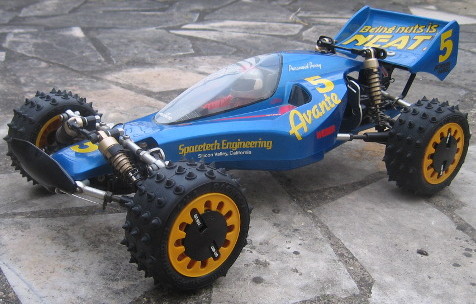
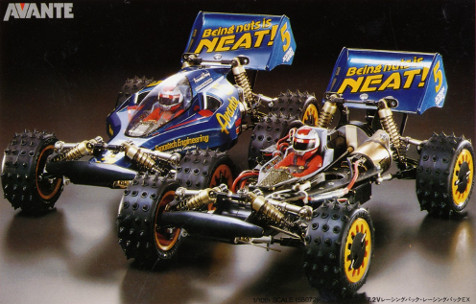
The Avante is a an icon, a revolution, an extraordinary technological leap forward that will deeply and durably leave its print in Tamiya history. But the Avante will also be a total surprise for the entire RC business, from other manufacturers designers to journalists and the public. Here are some hi-res photos to illustrate what is the Avante: this gallery gathers both period documents from the RC Guide Books and photos from the 2011 re-release. These photos are clickable.
What a car! At the first sight, any RC fan at the time (and still today) will love the Avante pure lines. But not only: before having a look under the drop-shaped bodyshell, some elements already show extremely novative solutions Tamiya designers used on the model. More precisely, the Avante is a design from M. Fumito Taki, one of the most important person in Tamiya RC history because he is the father of Tamiya's most significant models:
- the M4 Sherman tank reference RT-1601: the first RC model in 1974
- the Porsche 934 RSR : the first RC car in 1976
- the SRB buggies: the first RC buggies in 1979
- the Hotshot: the first 4WD RC buggy in 1985
Among others, because M. Fumito Taki was probably involved in other Tamiya models. I recommend you to read the Tamiya company article because it contains more detailed information about M. Fumito Taki and his role at Tamiya (the link to this article can also be found at this end of this page).
Back to the Avante: not giving too many details, suffice to say that the RC world remembers the Avante for the number and the nature of the technical innovations it carries. Without any doubt, this car was made to win races, but it had a second important role to play: to be Tamiya's technological know-how demonstration. At the time, the Avante perfectly played its role by offering technologies and innovative solutions the competitors still hadn't, many of these technologies becoming industry standards in the following years.
With the Avante, Tamiya made an outstanding demonstration of engineering all the RC industry remembers. Commercially, the Avante didn't sell very well due to its high price-tag. But the most important problem was the Avante failing to win any significant result in racing. In fact, the Avante should have been (and had to be) the best race performer of its time: on the contrary, the car was too complicated to setup and to maintain, some parts were too fragile and overall, the car was too heavy compared to competitors.
For the general public, Tamiya's customers, the Avante was simply not a model responding to their demands, both due to its complexity and price. This is why Tamiya soon offered a less expensive model with the Vanquish.
58076 Vanquish (1988)
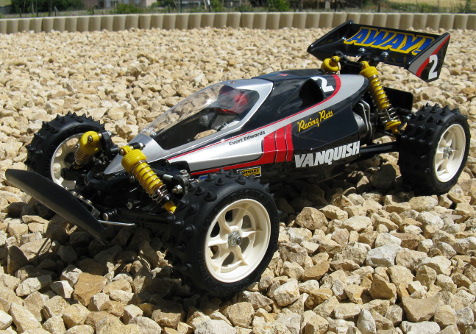
The Vanquish drivetrains and available options
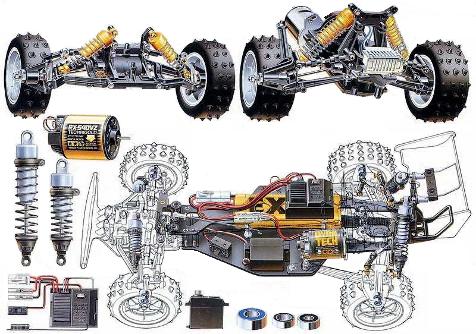
Promotional video of the Avante (© Tamiya)
Promotional video of the Vanquish (© Tamiya)
For the Vanquish, Tamiya massively used plastic wherever the Avante used carbon, the arms were simplified and the chassis is a bathtub-type (longer than the Avante's by 2.5cm). Most ball bearings disappeared, the 540VZ Technigold was replaced by the standard Mabuchi 540 and the outstanding Hi-Cap dampers replaced with yellow CVAs.
Tamiya soon realized the Avante flaws and tries to correct them with the Egress. This second generation mainly improved the front suspension travel and the overall reliability. But the Egress failed too at winning significant races, so did fail the Avante 2001, the last generation from 1990. This last version can be considered as the ultimate and corrected Avante design: too late, because all the “useful” innovations introduced by the Avante are now used by competitors too. So the Avante 2001 is released too late to be significant on the racing scene, the chassis design lost its charm in the quest of performance and reliability and the model did not sell well.
58079 Egress (1989)
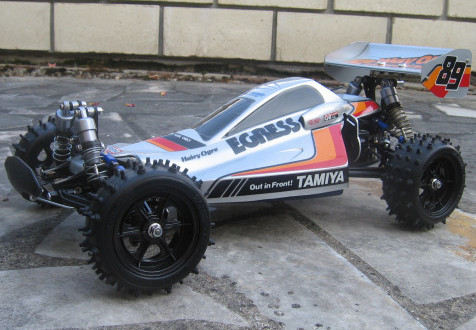
58085 Avante 2001 (1990)
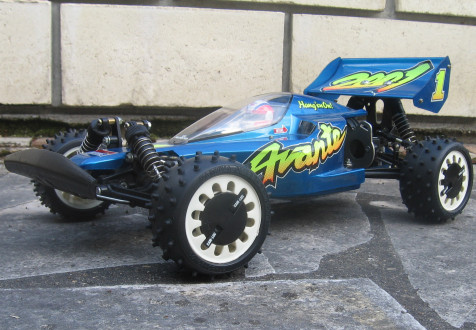
In the end, RC fans loved the models of this series afterwards, in particular the Avante and the Egress which are now considered as iconic and highly desirable. The Vanquish and the Avante 2001 remain quite anonymous though, including in recent years in the middle of the Vintage nostalgia.
Well, there is still one more model to review on this platform:
58497 Vajra (2011)
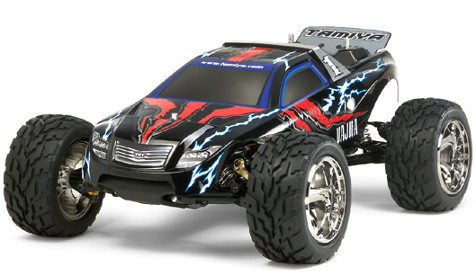
The chassis
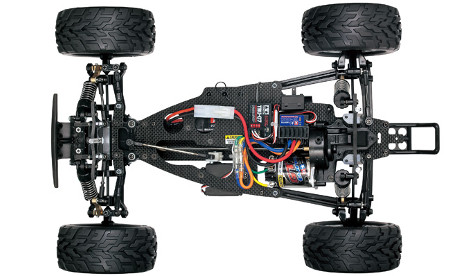
The Vajra (diamond or thunderbolt in Sanskrit) is a strange model that was released shortly after the Avante re-release in 2011. The chassis is a longer wheelbase Avante chassis and arms are borrowed from the Vanquish: so, in short, it is a Stadium Truck based on the Vanquish, but because that model hasn't been re-released (yet?), the chassis is presented as a longer re-released Avante chassis. Oh well.
This model is the only one to use the Avante chassis Stadium Truck variant, and as it seems, it should remain the only one. Indeed, this model is pretty expensive (the Avante isn't cheap) and it is 4WD when most other Stadium Trucks are 2WD vehicles. In addition, even in re-released form, the Avante chassis is not the most solid around. So in the end, the Vajra is not much liked, both due to its price and the fact that not many people think it has any any pertinence on the market, at least on this side of the planet. Difficult to understand what Tamiya meant with this model, but at least half of the RC planet didn't get it.
Conclusion on the Avante platform
With the Avante, Tamiya massively invested to reach the highest levels of the 4WD buggy international racing sector. The designers made an outstanding technological jewel, very much of a technological lead for its time, that will definitely make history in RC, but not the way Tamiya would have liked. Indeed, the Avante is one of the best example of such over-engineering that it can't reach the two most important aspects of racing: reliability and performance. The Egress will correct most Avante flaws, but despite being pretty much loved by club racers, it will never score any international point.
However, the Avante very advanced design will leave many tracks, both used by competitors as new standards and in the rest of Tamiya further productions. As an example, the longitudinally oriented motor and the battery pack placed in parallel of the central driveshaft will last as industry standards for years. Not forgetting the foam inserts in the tires or the major leap ahead the Hi-Cap dampers were for modern RC suspension systems.
Strategically, the Avante is extremely important for Tamiya: despite failing to achieve international results, the insufficient sales volumes ad the design flaws, this model is the demonstration of the highest-end know-how of the manufacturer, very much in advance of any competitor at the time. The Avante is also the proof of Tamiya's firm decision to enter high-end racing, and a proof of their ability to massively invest for that purpose, both in terms of engineering and industrial ressources. The most perceptive observers at the time would have paid very close attention to this model and what it represented. Short-sighted observers probably laughed at the design flaws: at the time already, “haters” were harsh and narrow-minded.
Because the Avante is the real starting point of the RC modern era for Tamiya, but to a large extend, for the RC industry in general too. Take the quality of materials or the precision of assembly: the Avante can easily compare to any of today's best available productions, and even beat several, actually. From this perspective, a modern TRF model (or any equivalent from another manufacturer) is not significantly better in quality or with a better adjustment quality than the Avante was almost 30 years ago.
But the Avante, it is also the foundation of a real strategy to reach the highest levels in international racing: indeed, this model is the very first tested by an entirely new department, the now world famous TRF Team (Tamiya Racing Factory Team). This department joins professional drivers and dedicated engineers: it was founded back in 1988 to test the Avante and to test-run it in official races. But the main goal is to design the best performing models and to make Tamiya reach the highest levels in international racing. If the performance of the Avante made a few so-called “drivers” or competitors smile at the time, the basis this model founded later proved how pertinent and efficient they were. Masterfully.
Related articles:
- Tamiya: the company (including M. Fumito Taki's role)
- 58489 Avante 2011













